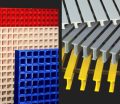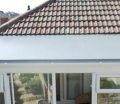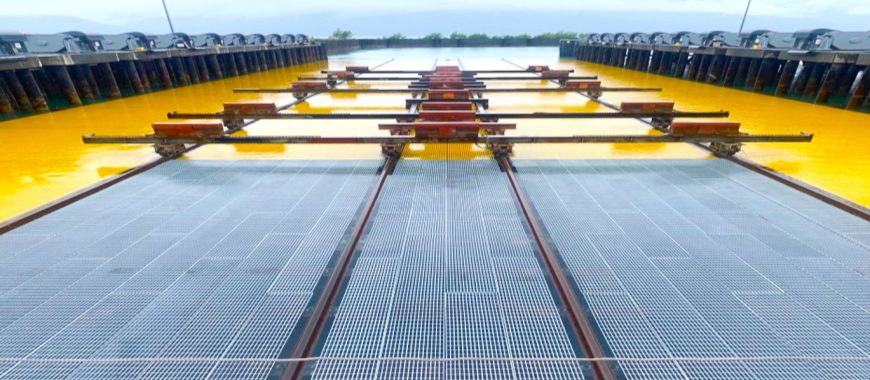
Pultruded FRP, or Fiber-Reinforced Polymer, represents a cornerstone in the composites industry, marrying the strength of fiber materials with a polymer matrix through the pultrusion process. The term “pultruded” stems from the process itself, where continuous strands of fiber are pulled through resin, impregnated, and then formed into a rigid structure as it cures. Celebrating over half a century of development, pultruded FRP technology continues to evolve, consistently offering improvements over its inception period that began in the 1950s. Pultruded FRP is a manufacturing process used to creates continuous lengths of FRP with non-conductive, strong, durable and lightweight. Unlike traditional building materials such as steel or wood, pultruded FRP offers a unique amalgam of robustness, lighter weight, and superior resistance to environmental degradation, positioning itself as a go-to material for innovative construction and manufacturing endeavors.
The Pultrusion Process: An Innovative Approach to Pultruded FRP
Pultruded fiberglass reinforced polyester (FRP) offers a compelling combination of strength, durability, and lightweight characteristics, which are achieved through the pultrusion process. This process allows for the production of continuous lengths of composite material and provides significant advantages over traditional manufacturing methods.
Detailed Description of the FRP Pultrusion Process
The FRP pultrusion process is a continuous manufacturing method that produces high-strength composite material profiles. It involves pulling raw materials through a series of steps to form a finished product, ensuring that the resultant pultruded FRP has consistent quality and performance characteristics.
Raw Materials and Their Properties
Before delving into the specifics of the pultrusion process, it is essential to understand the various inputs that contribute to the unique properties of pultruded FRP products. Here are the primary materials:
- Fibers: These are typically made from glass, carbon, or aramid and offer tensile strength and rigidity.
- Resin: Serves as the matrix material, binding the fibers and providing resistance to environmental factors.
- Fillers: They can be used to modify the physical properties of the FRP, including density and formability.
- Additives: These include a range of substances added to enhance the performance, such as catalysts, UV inhibitors, and flame retardants.
- Surfacing Veils: These materials are integrated to provide a better finish and additional protective properties to the surface of the FRP.
- Core Materials: Sometimes integrated into the FRP to increase thickness and structural strength with minimal weight addition.
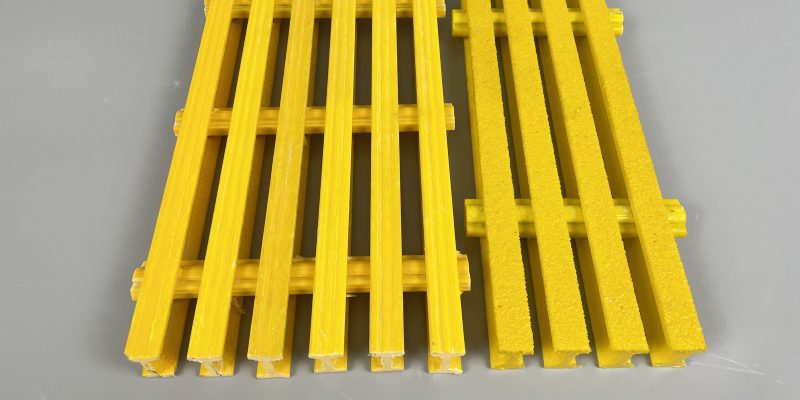
Advantages of Using Bell and Spigot FRP Pipe Systems
Step-by-Step: Manufacturing Pultruded FRP Profiles
Understanding the manufacturing process of pultruded FRP profiles reveals the complexity and the precision required to produce these innovative materials.
- Creeling: This is the setup stage, where fibers are unwound and aligned for the subsequent impregnation step.
- Resin Impregnation: In this stage, fibers are saturated with resin to ensure they bond well and are protected.
- Preform Guides: They help in shaping the material before it enters the main stage of the die for finalizing the profile.
- Die Heating and Curing: Within the heated die, the composite material is shaped, and the resin is cured into a solid form.
- Continuous Pulling: A system is used to continuously pull the profile through the die to maintain a uniform quality.
- Cutting to Length: As the profile comes out of the die, cutting equipment trims it to the desired lengths.
- Finishing: The last step often involves additional processes such as drilling or coating, depending on the intended use of the product.
The Role of FRP Pultrusion Machines in the Manufacturing Process
The pultrusion process would not be possible without the specially designed machines that ensure each step is carried out with precision.
- Pulling Mechanism: The heart of the machine that provides the necessary force to draw the materials through the entire process.
- Die Station: Critical for shaping and curing the profile, the die station must maintain precise temperature and pressure conditions.
- Resin Bath: A key stage where the resin impregnation of fibers takes place, crucial for the final material properties.
- Creel System: Organizes the fiber rolls and maintains the correct tensioning and feeding into the system.
- Cutter: Ensures that the finished profiles are cut with precision to the required lengths.
- Control Panel: Allows technicians to monitor and adjust production parameters for the highest efficiency and quality.
Differences and Advantages Over Filament Winding Process
When evaluating pultruded FRP, it is helpful to compare it with other manufacturing processes like filament winding to better appreciate its unique benefits.
| Feature | Pultruded FRP | Filament Winding |
|---|---|---|
| Process Introduction | Pultrusion is a process that produces consistent and uniformly shaped profiles by pulling fiber-reinforced materials through a heated die. | Filament winding involves wrapping fibers coated in resin around a rotating mandrel, producing components with a varied shape, often cylindrical. |
| Product Cross-section | The profiles produced through pultrusion are consistent in cross-section, allowing for precise design capabilities. | Filament winding can create more diverse shapes but is often limited to axisymmetric parts like pipes and tanks. |
| Material Orientation | Pultrusion predominantly aligns fibers in a single direction, which is along the length of the profile for optimal longitudinal strength. | Filament winding can strategically align fibers in multiple directions, offering tailored strength properties. |
| Production Speed | Pultrusion is highly efficient, capable of producing large volumes of uniform profiles quickly. | Filament winding is generally slower due to the intricate nature of wrapping the fibers and can be impacted by the complexity of the part. |
| Flexibility | Pultrusion is somewhat limited in that it can primarily produce profiles with a consistent cross-section throughout their length. | Filament winding is very flexible, allowing for the creation of complex structures and variations in wall thickness. |
| Strength Properties | Pultruded FRP excels in providing high longitudinal strength, which is desirable for many structural applications. | Filament-wound components have the advantage of isotropic or near-isotropic strength properties, which can be critical depending on the application. |
Through this comparison, it is evident that pultruded FRP stands out for manufacturing long, uniform profiles quickly and efficiently, while filament winding offers greater flexibility in shapes and strength characteristics.
Benefits of Pultruded FRP Materials
The use of pultruded FRP (Fiber Reinforced Polymer) materials has become increasingly popular across numerous industries due to their superior properties when compared to traditional materials such as metal and wood. Below are nine distinct benefits that highlight why “pultruded frp” is the material of choice for so many applications:
- Lightweight Nature: Pultruded FRP materials are significantly lighter than traditional materials like steel or aluminum, which makes them highly beneficial in industries where weight is a critical constraint. The lightweight feature results in easier handling and transport, leading to potential cost savings in shipping and installation, as well as improved fuel efficiency in automotive and aerospace applications.
- High Strength-to-Weight Ratio: Despite their lightness, pultruded FRP materials do not sacrifice strength. They possess a high strength-to-weight ratio, which is essential for structures that require robustness without the additional heft, such as in the automotive or aerospace industry, where every ounce matters for performance and fuel economy.
- Corrosion Resistance: The resistance of pultruded FRP materials to corrosion is a major advantage in environments that are harsh on metals. This includes exposure to chemicals, saltwater, and other corrosive substances. FRP materials can endure these conditions without degrading, thereby reducing maintenance costs and prolonging the service life of the products made from them.
- Versatility in Structural Shapes and Profiles: The manufacturing process of pultruded FRP allows for a wide range of structural profiles and shapes. This versatility means that designers and engineers have greater freedom to tailor their designs to specific needs and can create parts and structures that might be difficult or impossible to forge with other materials.
- Environmental Resistance: Apart from resisting corrosion, pultruded FRP materials can withstand various environmental factors such as UV radiation, moisture, and extreme temperature fluctuations. This resilience ensures that they retain their physical properties and appearance over time, making them ideal for outdoor or exposed structures.
- Non-Conductive Properties: Non-Conductive Properties: The non-conductive nature of pultruded FRP materials makes them safe for use in electrical applications. This quality is particularly important in the construction and maintenance of electrical insulation components, such as frp electrical insulation sheet, and can contribute to overall operational safety.
- Thermal Insulation: Pultruded FRP materials are natural thermal insulators. They do not conduct heat as metals do, which makes them valuable components in systems where thermal barriers are necessary, such as in building construction and HVAC systems, aiding in energy conservation and efficiency.
- Aesthetic Flexibility: Pultruded FRP can be produced in a range of colors and finishes, providing an aesthetically pleasing quality that can be tailored to match or complement various design preferences. This aesthetic flexibility is not only pleasing to the eye but also eliminates the need for additional painting or finishing in many cases.
- Low Maintenance Needs: Due to their durability and resistance to environmental wear and tear, pultruded FRP materials require much less maintenance compared to materials like wood or metal. The low maintenance requirement translates to cost savings and less downtime for repairs and replacements over the products’ lifespan.
The mentioned benefits clearly outline why pultruded FRP materials are an ideal choice for many construction and manufacturing applications. Their unique qualities help to mitigate common issues associated with other materials, paving the way for more innovative, cost-effective, and durable solutions across industries.
Pultruded FRP (Fiber Reinforced Polymer) grating is an advanced composite material that plays an essential role in various industries due to its durability, strength, and corrosion resistance. Pultruded grating refers to a frame of parallel or crossed bars used as a cover for an opening or as a platform, and when made from pultruded FRP, it becomes an extremely versatile product favored by many sectors.
The use of pultruded FRP grating is widespread and varied. Here are six points that help to understand how this material is employed across different settings:
- Walkways and Work Platforms: Pultruded FRP grating is often used for constructing walkways and work platforms, especially in industrial settings. Its high strength-to-weight ratio ensures it can support heavy loads despite being relatively lightweight, which is important for both safety and structural integrity.
- Chemical Resistance: Many industries require materials that can withstand harsh chemicals. Pultruded FRP gratings are impervious to many corrosive substances, making them suitable for usage in chemical processing plants where spills and exposure to aggressive agents are common.
- Anti-Slip Surface: Safety is a prime concern in any facility. Pultruded FRP grating can include anti-slip surfaces, reducing the risk of workplace accidents. This is crucial for maintaining employee safety and adhering to occupational health standards, especially in areas like fiberglass road systems where slip resistance is vital for vehicle and pedestrian traffic.
- Electrical Insulation: In environments where electrical hazards are present, grating must be non-conducive. Pultruded FRP does not conduct electricity, providing an additional safety measure in such settings.
- Water and Wastewater Treatment: Due to its corrosion resistance and reduced maintenance needs, pultruded FRP grating is often used in water and wastewater treatment facilities. It can withstand continuous moisture exposure without deterioration.
- Architectural Applications: Pultruded FRP grating offers aesthetic options and can be used for architectural features such as decorative screens or vent covers, providing both style and function.
Typical Applications and Advantages in Context
Pultruded FRP grating is not just versatile but particularly advantageous in specific environments. A few points illustrating its applications and related benefits include:
- Chemical Plants: In chemical plants, the grating resists a multitude of corrosive substances and facilitates strict hygiene and cleaning protocols, improving facility safety and lifespan.
- Marine Environments: The pultruded FRP’s ability to withstand saltwater and weathering makes it perfect for docks, piers, and other marine applications, significantly reducing the need for repairs common in these harsh environments.
- Oil and Gas Industry: The industry’s demanding conditions with exposure to various hydrocarbons are where pultruded FRP gratings thrive due to their resistance to corrosion and minimal maintenance requirements.
- Utility Access: For applications where utility access is crucial, such as in telecom or electrical sectors, pultruded FRP grating provides the necessary support without interfering with EM or RF signals.
- Food and Beverage Facilities: The ease of cleaning and resistance to microbial growth are reasons pultruded FRP grating is favored in food and beverage processing areas.
- Pharmaceuticals: In clean room environments, grating must not contribute to contamination. Pultruded FRP is non-porous and does not rust, making it suitable for such sterile applications.
- Transportation: Lightweight grating is valuable in transport infrastructure, where it can reduce the load on bridges and platforms and provide durability without heavy weight for vehicle ramps and pedestrian pathways.
- Recreation: Recreational facilities such as pools, sports venues, and parks benefit from the low maintenance and aesthetic flexibility of pultruded FRP grating, accommodating both functionality and design objectives.
Pultruded FRP grating’s unique properties and adaptability make it a dependable solution in supporting the needs and operational challenges of a wide array of industrial sectors. It provides a combination of safety, performance, and longevity that is unparalleled by traditional materials, solidifying its position as a cornerstone in the construction and design of industrial applications.
Certainly! Here’s an expanded section on Fiberglass Pultrusion, focusing on its role as the backbone of Pultruded FRP, while integrating the specified instructions.
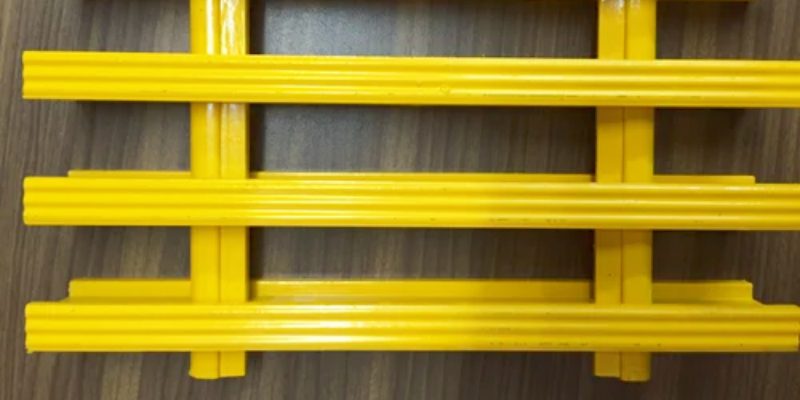
Pultruded FRP Technology
Pultruded FRP Technology refers to a specialized manufacturing process used to create Fiber Reinforced Polymer (FRP) composites with consistent cross-sectional shapes. Pultrusion is derived from the combination of “pull” and “extrusion,” indicating that the material is pulled through a die to form a desired profile. This technology is widely used to produce lightweight, strong, and corrosion-resistant structural components.
Key Elements of Pultruded FRP Technology
- Raw Materials:
- Reinforcements: Fibers such as glass, carbon, or aramid are used to provide strength. Glass fibers are the most common due to their cost-effectiveness and mechanical properties.
- Resins: Thermosetting resins like polyester, vinyl ester, or epoxy are used to bind the fibers and create a rigid matrix.
- Additives: Fillers, pigments, and UV inhibitors are added to enhance specific properties like color, durability, or weather resistance.
- Pultrusion Process:
- Fiber Preparation: Fibers are unwound from spools and aligned through a series of guides to ensure consistent reinforcement placement.
- Resin Impregnation: Fibers pass through a resin bath where they are thoroughly saturated with the resin matrix.
- Pre-Forming: The saturated fibers are shaped into the preliminary form before entering the heated die.
- Pultrusion Die: The material is pulled through a heated die where it is cured under controlled temperature and pressure. The die imparts the desired cross-sectional shape.
- Cooling and Cutting: The cured profile is cooled and then cut to the required lengths.
- Advantages of Pultruded FRP Technology:
- High Strength-to-Weight Ratio: Pultruded FRP components are lightweight yet extremely strong, making them suitable for load-bearing applications.
- Corrosion Resistance: Unlike metals, FRP does not corrode, making it ideal for harsh environments like marine, chemical, and wastewater treatment industries.
- Dimensional Consistency: The process ensures uniformity in cross-sectional profiles, making the components highly precise.
- Design Flexibility: A wide range of shapes and sizes can be produced to meet specific application needs.
- Low Maintenance: Pultruded FRP components require minimal upkeep, reducing long-term costs.
- Applications:
- Construction: Beams, channels, and grating used in buildings, bridges, and decks.
- Infrastructure: Utility poles, pipelines, and guardrails.
- Transportation: Components for automotive, aerospace, and marine industries.
- Industrial: Chemical-resistant tanks, platforms, and ladders.
- Sustainability:
- Pultruded FRP technology supports sustainable practices due to its durability, lightweight nature (reducing transportation energy), and long service life, minimizing the need for replacements.
This technology has become a cornerstone in industries where high-performance materials are required, offering a competitive alternative to traditional materials like steel, aluminum, and wood.
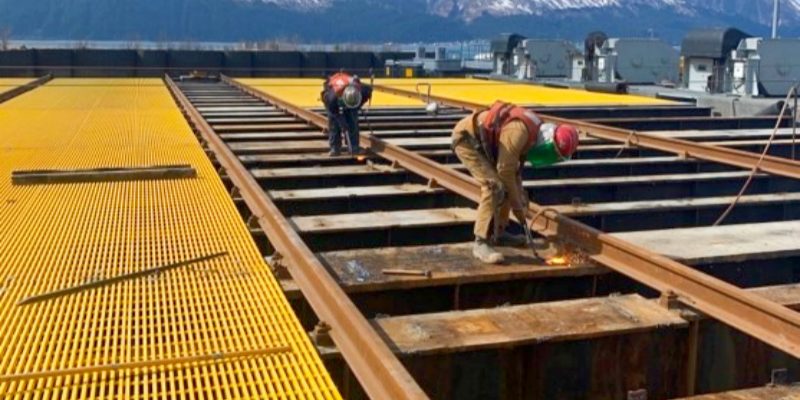
Molded vs. Pultruded FRP
Molded FRP (Fiberglass Reinforced Plastic)
Molded FRP is a composite material made by embedding fiberglass reinforcement within a polymer resin, shaped into a specific form using molds. This manufacturing method is often employed for creating complex shapes and structures.
- Manufacturing Process:
- Fiberglass mat or woven roving is placed in a mold.
- Resin is applied, often using techniques like hand lay-up, spray-up, or compression molding.
- The material is cured, typically at room temperature or with added heat, to form the final product.
- Applications:
- Molded FRP is ideal for creating intricate shapes, such as tanks, domes, pipes, or gratings with custom contours.
- Commonly used in chemical storage, wastewater treatment, and decorative architectural components.
- Advantages:
- High flexibility in design and shape.
- Excellent corrosion resistance.
- Ability to create highly customized products.
- Limitations:
- Higher production time for complex shapes.
- Often labor-intensive, leading to potentially higher costs for large-scale production.
| Aspect | Molded FRP | Pultruded FRP |
|---|---|---|
| Production Method | Mold-based, shape-specific | Continuous pulling, linear profiles |
| Shapes | Complex, custom | Straight, consistent |
| Strength | Moderate, dependent on shape | High, with excellent consistency |
| Cost Efficiency | Higher for small runs, custom work | Higher for large-scale production |
| Applications | Tanks, pipes, custom gratings | Structural profiles, beams, channels |
Both materials have their strengths and are chosen based on application needs. Molded FRP excels in customization and design flexibility, while pultruded FRP shines in high-strength, repetitive structural applications.
Uses of Pultruded FRP
Pultruded FRP (Fiberglass Reinforced Plastic) is widely used across various industries due to its high strength-to-weight ratio, corrosion resistance, and durability. Below are some of the key applications:
Structural Applications
- Beams and Columns: Used in construction for structural support in buildings, bridges, and platforms.
- Channels and Angles: Utilized in frameworks and supporting structures in industrial and commercial settings.
- Handrails and Guardrails: Commonly used in industrial plants, offshore platforms, and walkways for safety.
Transportation and Infrastructure
- Bridge Components: Pultruded FRP is used in lightweight and corrosion-resistant pedestrian bridges, rail platforms, and road barriers.
- Railway Sleepers: Offers durability and resistance to weathering compared to traditional materials like wood or concrete.
- Cable Trays: Provides a non-conductive and corrosion-resistant solution for electrical infrastructure.
Industrial and Chemical Application
- Gratings and Walkways: Ideal for areas exposed to chemicals, such as wastewater treatment plants and chemical processing facilities.
- Cooling Tower Components: Used in cooling tower frameworks and fan stacks for their resistance to corrosion and high temperatures.
- Pipes and Ducts: Lightweight and durable pipes for corrosive environments.
Marine and Offshore Applications
- Dock Components: Includes decking, pilings, and railings for docks, marinas, and seawalls, due to resistance to saltwater and UV.
- Offshore Platforms: Used for ladders, handrails, and walkways where exposure to harsh marine conditions is constant.
Electrical and Utility Applications
- Non-Conductive Components: Used for cable ladders, transformer supports, and switchyard components in power generation.
- Insulating Materials: Due to their non-conductive properties, pultruded FRP is used in insulating equipment and housing.
Renewable Energ
- Wind Turbine Components: Pultruded profiles are used in the structural components of wind turbines for their strength and lightweight properties.
- Solar Panel Supports: Provides corrosion-resistant frames and structures for solar farms.
Recreation and Leisure
- Sports Equipment: Used in lightweight poles, rods, and frames for various sporting goods.
- Fencing and Decking: Durable, weather-resistant materials for outdoor recreational spaces.
Aerospace and Automotive
- Structural Parts: Lightweight components for aircraft, buses, and trucks to enhance fuel efficiency.
- Interior Applications: Non-corrosive and lightweight materials for partitions and paneling.
Agriculture
- Greenhouse Supports: Structural profiles for greenhouses due to their durability in humid and corrosive environments.
- Livestock Enclosures: Non-corrosive, easy-to-clean material for fencing and pens.
Emergency and Rescue Equipment
- Ladders and Poles: Used in rescue operations where lightweight, high-strength, and non-conductive properties are crucial.
- Safety Barriers: Deployed in disaster zones for quick and durable fencing solutions.
The Backbone of Pultruded FRP
Fiberglass is a pivotal element in the realm of composites, especially within pultruded FRP (Fiber Reinforced Polymer) structures. Its unique properties and versatility make it an irreplaceable component in many industrial applications, including in products like fiberglass composite panel, which are widely used for their durability and strength.
Fiberglass as a Crucial Component in Pultruded FRP Composites
- Strength-to-Weight Ratio: Fiberglass imparts exceptional strength to pultruded FRP while maintaining a lower weight compared to metal counterparts. This is vital in automotive, aerospace, and construction applications where weight savings are crucial for performance and efficiency.
- Corrosion Resistance: Unlike metals, fiberglass does not corrode when exposed to harsh environmental conditions. This characteristic makes pultruded FRP an ideal choice for outdoor structures, chemical plants, saltwater applications, and durable enclosures like a poly fiberglass box, which offers excellent protection in challenging environments.
- Electrical Insulation: Fiberglass is an excellent insulator, making pultruded FRP products perfect for electrical applications, including utility poles, cross-arms, and enclosures that require non-conductive materials for safety and performance.
- Dimensional Stability: The thermal expansion rate of fiberglass is significantly lower than that of metals, providing pultruded FRP with exceptional dimensional stability under fluctuating temperatures. This property is essential for applications requiring precise tolerances and reliability.
- Design Flexibility: The pultrusion process allows for a wide range of cross-sectional profiles, making it possible to design complex shapes that meet specific engineering requirements, thus enhancing the versatility of pultruded FRP in various applications.
- Cost-Effectiveness: When considering the lifecycle costs, pultruded FRP composites offer significant savings due to their durability, low maintenance requirements, and longevity compared to traditional construction materials.
Best Clear Epoxy Resin for FRP Pipe in Outdoor Use
How It Differs From the Complete FRP Pultrusion Process
- High Throughput: The continuous nature of the pultrusion process enables high-volume production, making it more efficient and cost-effective for large-scale applications.
- Consistent Quality: Fiberglass pultrusion results in products with uniform properties and dimensions, ensuring reliable performance and quality in pultruded FRP applications.
- Energy Efficiency: Compared to other manufacturing processes, pultrusion requires less energy, contributing to the overall sustainability of producing pultruded FRP products.
- Versatility in Applications: From structural components, such as beams and columns in construction, to utility poles and wind blade spars, the applications of pultruded FRP are vast and varied, highlighting its adaptability to different industries.
- Customization: The pultrusion process allows for the incorporation of various resin types, additives, and reinforcements to tailor the properties of the final pultruded FRP product to specific needs.
- Environmental Impact: Fiberglass pultrusion is a relatively clean manufacturing process with minimal waste, especially when compared to traditional materials like steel or aluminum, which require significant energy and produce considerable waste in their production.
- Differences From Other FRP Processes: Unlike other FRP manufacturing processes that may involve hand lay-up or spray-up methods, pultrusion is highly automated, ensuring consistent cross-sections and lengths. The focused nature of pultrusion on linear, continuous profiles sets it apart from more labor-intensive and less consistent methods.
- Future Innovation Potential: With ongoing research and development, the pultrusion process continues to evolve, expanding the potential applications and efficiency of pultruded FRP. Innovations in materials, resin formulations, and process technology promise to enhance performance, sustainability, and cost-effectiveness.
In summary, the fiberglass pultrusion process plays a critical role in the functionality and success of pultruded FRP composites, bridging the gap between traditional materials and future advancements in construction, manufacturing, and beyond.
GangLong Fiberglass: Pioneering Pultruded FRP
GangLong Fiberglass stands as a hallmark in the world of composites, particularly in the arena of pultruded Fiber Reinforced Polymer (FRP). Notably advancing the pultrusion process, GangLong has not only contributed to the evolution of this technology but has also carved out a niche for itself as a pioneer in pultruded FRP solutions. Their work encompasses various industries, demonstrating the versatility and strength of pultruded FRP in real-world applications.
The Contribution of GangLong Fiberglass to the Pultrusion Industry
GangLong Fiberglass has made significant strides in advancing pultruded FRP technology and its applications, underlined by the following points:
- Innovative Pultrusion Techniques: GangLong has developed unique pultrusion techniques to create FRP profiles with complex shapes and superior mechanical properties, setting new standards in the industry.
- Customized FRP Solutions: They offer tailor-made pultruded FRP solutions to meet the specific needs of different industries, including aerospace, construction, and marine.
- Sustainability Focus: Recognizing the importance of sustainability, GangLong’s processes are designed to minimize waste and reduce environmental impact, leveraging the inherent energy efficiency of pultruded FRP.
- Advanced Material Usage: By incorporating high-performance resins and fibers, GangLong enhances the durability, strength, and corrosion resistance of their pultruded FRP products.
- Pioneering Structural Applications: GangLong has been at the forefront of using pultruded FRP for structural applications, showcasing its potential as a lightweight yet strong alternative to traditional materials.
- Collaborative Projects: They actively engage in collaborations with research institutions and other companies to push the boundaries of pultruded FRP technology.
- Educational Initiatives: GangLong is committed to educating the industry and clients about the benefits and capabilities of pultruded FRP, hosting seminars and workshops.
- Quality and Certification: Upholding the highest quality standards, GangLong’s pultruded FRP products are certified under relevant industry standards, ensuring reliability and performance.
Case Studies Exemplifying the Capabilities of Pultruded FRP
GangLong Fiberglass’ excellence in pultruded FRP can be further illustrated through the following real-world examples and case studies:
- Infrastructure Project: GangLong contributed to a major infrastructure project by supplying pultruded FRP beams for a pedestrian bridge. This showcased the material’s strength and endurance, along with its resistance to environmental wear.
- Marine Application: They designed and manufactured custom pultruded FRP profiles for a marine application, significantly enhancing the durability and performance of the marine structures against harsh saline environments.
- Utility Poles: GangLong’s pultruded FRP utility poles, used in rural areas, demonstrated its superior strength-to-weight ratio, resistance to weathering, and easy installation process, marking a significant improvement over traditional materials.
- Architectural Features: In an architectural project, GangLong supplied pultruded FRP components that were integral to the aesthetic and structural integrity of the building, highlighting the material’s versatility in design and application.
- Wastewater Treatment Plants: They have delivered pultruded FRP grating and structural profiles for wastewater treatment plants, which require materials resistant to chemicals and corrosion, illustrating the material’s resilience and longevity.
- Aerospace Components: GangLong’s contribution to the aerospace industry with pultruded FRP components demonstrates the material’s lightweight, high-strength characteristics, critical for aerospace applications where every ounce matters.
These examples underscore GangLong Fiberglass’ role as a leader in pioneering pultruded FRP applications across diverse sectors, affirming their commitment to innovation, sustainability, and excellence in composite engineering. Through their ongoing efforts, GangLong continues to expand the possibilities of pultruded FRP, driving forward the composites industry while meeting the ever-evolving needs of their clients.
Final Thoughts: The Growing Impact of Pultruded FRP
The revolution in material engineering has brought us pultruded fiber-reinforced polymers (FRP), a material that stands out for its strength, versatility, and sustainability. As industries worldwide strive for innovation and efficiency, understanding the full potential and varied applications of pultruded FRP has never been more critical. Let’s dissect the key aspects of pultruded FRP, explore its future potential in various industries, and suggest directions for those ready to capitalize on this game-changing material.
Summary of Key Takeaways About Pultruded FRP
Before delving into the specifics, it’s crucial to grasp the overarching benefits that pultruded FRP offers. Its attributes like high strength-to-weight ratio, design adaptability, and environmental resilience make it a prime choice for forward-thinking projects. Here are some pivotal points to remember:
- High Strength-to-Weight Ratio: Pultruded FRP excels in delivering superior strength while being significantly lighter than traditional materials.
- Corrosion Resistance: Ideal for corrosive environments, pultruded FRP withstands conditions that would degrade most metals.
- Thermal Insulation: Offers excellent insulation, helping in energy conservation across numerous applications.
- Design Flexibility: The versatility in shapes and sizes that can be achieved through pultrusion opens up innovative design possibilities.
- Cost-Effectiveness: Though initial costs may be high, the durability and low maintenance of pultruded FRP offer long-term savings.
- Sustainability: Its potential for recycling and lower environmental impact make pultruded FRP a green choice in material selection.
Customization Possibilities with Molded FRP Pipe Designs
Future Outlook of Pultruded FRP’s Role in Various Industries
As we peer into the future, the role of pultruded FRP across different sectors is only expected to expand. Its unique properties align well with the global push towards more efficient, sustainable, and resilient industrial practices. Here’s how it might unfold across various domains:
- Construction Sector: The demand for lightweight, durable materials in urban development projects will likely increase pultruded FRP’s application in building and infrastructure.
- Automotive Industry: As the automotive sector evolves with a focus on fuel efficiency and emissions reduction, the adoption of pultruded FRP could significantly rise.
- Power Generation: Durability in harsh environmental conditions makes pultruded FRP a top candidate for components in renewable energy infrastructures.
- Telecommunications: Non-conductive, lightweight properties of pultruded FRP suit the growing needs of the telecommunications sector.
- Marine Applications: Its resistance to corrosion positions pultruded FRP as an ideal material for a wide range of marine and coastal projects.
- Environmental Management: Given its chemical resistance, pultruded FRP’s utility in environmental protection and water treatment projects is set to grow.
By recognizing the wide-ranging applications and future potential of pultruded FRP, stakeholders across industries can make more informed choices, pushing the envelope of what’s possible in modern projects.
FAQs about Pultruded FRP
FRP stands for Fiber-Reinforced Polymer, a composite material made from a polymer matrix reinforced with fibers. The term “pultruded” refers to the method used to manufacture FRP products. In the pultrusion process, continuous lengths of fiber, such as glass or carbon, are pulled through a liquid resin mixture (usually consisting of a thermosetting resin like polyester or vinyl ester) and then through a heated die where the resin undergoes polymerization, or curing. This process results in products with a high strength-to-weight ratio and excellent corrosion resistance. FRP pultruded products are diverse and can range from structural shapes (like I-beams, angles, channels) to rods, tubes, and more specialized profiles designed for specific applications.
Pultruded material refers to any product made by the pultrusion process, which involves pulling fiberglass or other reinforcing fibers through a resin bath and then through a heated die, where the resin hardens or cures to form a solid shape. This continuous manufacturing process leads to materials that are structurally strong, lightweight, and highly resistant to corrosion and wear. Due to these properties, pultruded materials find wide-ranging applications, including in the construction, automotive, and electrical industries, among others. They are prized for their durability and adaptability, catering to needs for both generic and specialized profiles.
The three primary types of Fiber-Reinforced Polymers (FRP) are based on the type of fibers used for reinforcement:
Glass Fiber-Reinforced Polymer (GFRP): This is the most common type, utilizing glass fiber as reinforcement. It offers a good balance of strength and cost, making it a popular choice for various applications, from automotive parts to building reinforcement.
Carbon Fiber-Reinforced Polymer (CFRP): With carbon fibers providing the reinforcement, CFRP offers a higher level of strength and stiffness than GFRP. It is lighter but more expensive, frequently used in high-performance applications such as aerospace, sporting goods, and high-end automotive.
Aramid Fiber-Reinforced Polymer (AFRP): Often known by the brand name Kevlar, aramid fibers give AFRP exceptional strength and energy-absorbing properties. This makes it ideal for ballistic and protective applications, as well as reinforcement in impact-prone areas.
These categories highlight the adaptability of FRP to fulfill specific performance requirements, whether the priority is cost-efficiency, strength, stiffness, or impact resistance.
The pultruded fiberglass process is a continuous manufacturing method used to produce fiber-reinforced polymer (FRP) composites with consistent cross-sectional shapes. Here’s a step-by-step overview:
Roving Fiberglass: Continuous strands of glass fiber are pulled off rolls and may be guided through a bath of resin mixed with certain additives and fillers. Sometimes, mats of fibers or fabrics are also included to improve strength in various directions.
Resin Impregnation: The fibers are thoroughly impregnated with the resin mixture, ensuring that they are completely coated, which is key to the strength and quality of the final product.
Forming and Curing: The wet-out fibers then enter a heated die that shapes the material into its final form. Inside this die, the temperature is controlled to initiate the curing of the resin, which solidifies the composite material.
Continuous Pulling and Cutting: The continuous rod, tube, or structural shape exits the die, is cooled, and is then cut into predetermined lengths.
This process results in materials that offer an exceptional strength-to-weight ratio, durability, and resistance to corrosion, making them suitable for a wide array of applications.
Pultruded structural FRP (Fiber Reinforced Polymer) profiles are lightweight, durable, and high-strength components made through the pultrusion process. These profiles are typically composed of a combination of glass or carbon fibers and a polymer resin matrix. The fibers provide strength and stiffness, while the resin binds the fibers and offers environmental resistance. Pultruded profiles are commonly used in construction, marine, transportation, and industrial applications because of their excellent corrosion resistance, high strength-to-weight ratio, and non-conductive properties.
Pultrusion is a continuous manufacturing process for producing FRP profiles with a constant cross-sectional shape. Fibers are impregnated with liquid resin and pulled through a heated die, where the resin cures and hardens. The pulling mechanism ensures consistent tension and alignment of fibers, resulting in strong, uniform profiles. Pultrusion is ideal for creating beams, channels, and rods with consistent dimensions and properties.
The molding process for FRP involves shaping fiber-reinforced polymers into specific forms using molds. Common methods include compression molding, where fiber mats and resin are placed in a heated mold and pressed; hand lay-up, where resin is manually applied to fiber layers; and vacuum infusion, which uses a vacuum to distribute resin over fibers. These processes can create complex shapes and structures, making them suitable for diverse applications like vehicle panels, pipes, and storage tanks.
The pultrusion process is widely applied in industries requiring lightweight, durable, and corrosion-resistant materials. Common applications include structural components in construction (beams, gratings, and stair treads), marine (decking and handrails), electrical (cable trays and insulators), and transportation (vehicle frames and railings). Pultruded profiles are also used in renewable energy, such as wind turbine blades, due to their high strength and dimensional stability.
The FRP process involves reinforcing fibers (like glass, carbon, or aramid) embedded in a polymer matrix (such as epoxy, polyester, or vinyl ester). This combination produces a composite material with enhanced mechanical and thermal properties. Manufacturing methods include pultrusion, filament winding, hand lay-up, and resin transfer molding. FRP is valued for its strength, corrosion resistance, and versatility across industries like aerospace, automotive, and construction.
Extrusion and pultrusion are both continuous manufacturing processes but differ significantly in material and technique. Extrusion uses heated materials like metals or plastics, which are pushed through a die to form a shape. Pultrusion, on the other hand, pulls fiber-reinforced materials through a resin bath and heated die to create FRP profiles. Extrusion is common for metals and plastics, while pultrusion is specific to composites like FRP.

As the editor of GangLong Fiberglass, I have years of experience and in-depth research, focusing on cable tray products, fiberglass solutions, and grille systems. I incorporate years of industry insights and practical experience into every content, committed to promoting the progress of the industry. At GangLong Fiberglass, my commitment is reflected in every product, from innovative cable trays to durable fiberglass solutions and sturdy grille systems. As an authoritative voice in the industry, my goal is to provide valuable information to professionals and businesses and promote forward-looking solutions.

